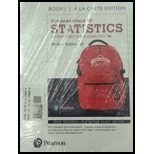
Concept explainers
In Problems 1 and 2, determine if the sampling is dependent or independent indicate whether the response variable is qualitative or quantitative.
1. A researcher wants to know if the mean length of stay in for-profit hospitals is different from that in not-for-profit hospitals. He randomly selected 20 individuals in the for-profit hospital and matched them with 20 individuals in the not-for-profit hospital by diagnosis.
To indicate: Whether the response variable is qualitative or quantitative variable.
Answer to Problem 1RE
The sampling isdependent.
The response variable is quantitative variable.
Explanation of Solution
Given info:
There are 2 groups in which 20 subjects are randomly allocated for group 1 and 20 subjects are randomly allocated for group 1. Also, the subjects are matched by diagnosis.
Justification:
Independent sample:
If the individuals from one sample do not associate with the individuals from other sample, then the two samples are said to be independent samples.
Dependent sample:
If the individuals from one sample is associated with the individuals from other sample, then the two samples are said to be dependent samples.
Here, the subjects are taken from the two groups and the subjects are matched by diagnosis. This indicates that the data are matched according to some inherent relationships. Therefore, the sampling isdependent.
Qualitative Variable:
It is used to classify the individuals on some attribute or characteristic.
Quantitative Variable:
It gives a numerical measurement of the individuals of population. The values of quantitative variables can be added or subtracted to get meaningful result.
Also, the response variable is the length of stay. Hence, the response variable gives a numerical measurement of the individuals of a sample.
Thus, the response variable is quantitative variable.
Want to see more full solutions like this?
Chapter 11 Solutions
Fundamentals of Statistics, Books a la Carte Edition Plus MyLab Statistics with Pearson eText -- Access Card Package (5th Edition)
- A company found that the daily sales revenue of its flagship product follows a normal distribution with a mean of $4500 and a standard deviation of $450. The company defines a "high-sales day" that is, any day with sales exceeding $4800. please provide a step by step on how to get the answers in excel Q: What percentage of days can the company expect to have "high-sales days" or sales greater than $4800? Q: What is the sales revenue threshold for the bottom 10% of days? (please note that 10% refers to the probability/area under bell curve towards the lower tail of bell curve) Provide answers in the yellow cellsarrow_forwardFind the critical value for a left-tailed test using the F distribution with a 0.025, degrees of freedom in the numerator=12, and degrees of freedom in the denominator = 50. A portion of the table of critical values of the F-distribution is provided. Click the icon to view the partial table of critical values of the F-distribution. What is the critical value? (Round to two decimal places as needed.)arrow_forwardA retail store manager claims that the average daily sales of the store are $1,500. You aim to test whether the actual average daily sales differ significantly from this claimed value. You can provide your answer by inserting a text box and the answer must include: Null hypothesis, Alternative hypothesis, Show answer (output table/summary table), and Conclusion based on the P value. Showing the calculation is a must. If calculation is missing,so please provide a step by step on the answers Numerical answers in the yellow cellsarrow_forward
 Glencoe Algebra 1, Student Edition, 9780079039897...AlgebraISBN:9780079039897Author:CarterPublisher:McGraw Hill
Glencoe Algebra 1, Student Edition, 9780079039897...AlgebraISBN:9780079039897Author:CarterPublisher:McGraw Hill College Algebra (MindTap Course List)AlgebraISBN:9781305652231Author:R. David Gustafson, Jeff HughesPublisher:Cengage Learning
College Algebra (MindTap Course List)AlgebraISBN:9781305652231Author:R. David Gustafson, Jeff HughesPublisher:Cengage Learning Big Ideas Math A Bridge To Success Algebra 1: Stu...AlgebraISBN:9781680331141Author:HOUGHTON MIFFLIN HARCOURTPublisher:Houghton Mifflin Harcourt
Big Ideas Math A Bridge To Success Algebra 1: Stu...AlgebraISBN:9781680331141Author:HOUGHTON MIFFLIN HARCOURTPublisher:Houghton Mifflin Harcourt


